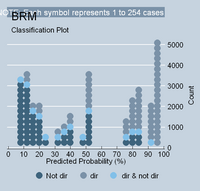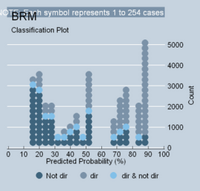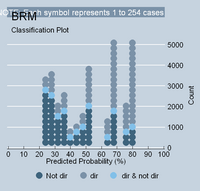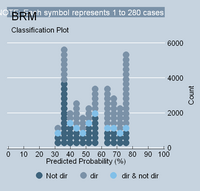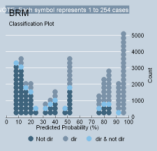What About the "Case Facts" Model?
 Saturday, August 19, 2006 at 3:28PM
Saturday, August 19, 2006 at 3:28PM [shared knowledge]
I want to briefly discuss another kind of "attitude model" that is often appealed to by political science scholars. It combines what its creators call “case facts” with measures of ideology into a multi-variate analysis of discreet areas of voting (e.g., search-and-seizure) (Segal and Spaeth 2002, 312-320, 324-326; Segal 1984). This model is called the “case-fact” model.
As others, however, have noted (Friedman 2006, 268), it is regrettable that the variables in these models are actually called “case facts.” In the case of Segal and Spaeth's (2002) search and seizure analysis, for example, the variables are probably better understood as circumstances that have been recognized by the Court to morally guide the process of intrusion. For example, what is said to be a "case fact” is whether the search is “incident to arrest;” involving warrants, probable cause and warrant “exceptions;” and occurring in the house, car, person or business (314-318). Obviously, the Court has created legal doctrine that specifically prescribes the propriety of police intrusion under of each of these searching circumstances. It really should not be surprising that a statistical model could be created that extracts searching-guideline criteria from doctrine announced in prior cases and then demonstrates that the criteria is a statistical predictor in the very cases where the doctrines were created or enforced. Simply labeling the announced circumstantial criteria governing the propriety of a search as “facts,” and then claiming that justices vote in cases based upon "the facts," does not allow one to escape the circularity problem that such variables really measure a doctrinal construct and “conclusions of law.” (Friedman, 268).
A more general problem is that “facts” themselves are rarely judged by appellate tribunals. It is the trial courts that judge the facts (innocent, guilty). That is the reason why trials frequently culminate in a document titled Findings of Fact. The appellate courts, on the other hand, harvest the already-judged facts into a prudential construct. To see this, consider once again the search and seizure example (318). Although Segal and Spaeth argue that what influences voting is the “fact” of where the search occurred (person, place, business, home, etc.), the reality is that the Court is organizing instances of the behavior of intrusion via comparison and contrast to form a Constitutional “meta-doctrine.” What emerges, then, is a prescriptive order about the propriety of intrusion that could probably be called the “territoriality theory" of Fourth Amendment jurisprudence. This theory says, quite simply, that your privacy rights are substantial in your home but not out in "public" (which is why the location of the search is a statistical predictor). Hence, what is being voted for is the construction of a theory of territoriality that governs a set of searching circumstances and that serves as a sort of a “meta-doctrine” for the whole area of Fourth Amendment jurisprudence. Segal and Spaeth, therefore, really do not have a true “case facts” model; they have a model that catches the residue or "particulars" of a doctrinal construct and then purports to predict the outcomes of searches in the very cases where the construct was created or enforced. The problem is as much about tautology as it is vocabulary.
So does that mean that judges never "judge facts?" Of course not. For a jurist to be truly a judger of facts, he or she must make a decision based upon an attribute of a case that is unrelated to legal doctrine. For example, let us say that a trial judge has to decide how many bloody crime-scene pictures to allow into evidence under the prejudice-versus-probity rule. Because this rule is governed by the abuse-of-discretion standard, there is really not much "law" (as in rules or -- I would argue - meaningful standards) to dictate the decision. The judge is generally free to let in any amount -- or even differing amounts -- of photos he or she desires. Let's say that Judge Judy has two murder cases, A and B. If she admits extra gruesome crime photos for Case A because it is a high profile case involving someone from a wealthy neighborhood, but admits a lower number for Case B because it is a poor neighborhood, that would be an example of using attitudes to judge facts. It would be judging facts because there is no evidence of doctrine sanctioning the "neighborhood-value" theory for the admissibility of crime photos. The judgment is therefore made based upon facts that were never woven into a prudential construct. Neither Judge Judy nor her peers are obliged to follow this criterion when judging photos in the future.
How would an appellate court "judge facts?" One way would be agenda access. If a state supreme court justice votes to place cases on the docket more often for campaign contributers than otherwise, that would be a ruling based upon facts unrelated to doctrine. The Supreme Court might engage in such behavior if it decided a case based upon a "concealed fact" -- i.e., a fact that was not processed into the explicit doctrine. Let's say that the Court strikes down a sodomy law using rational basis instead of strict scrutiny because, if it uses higher level review, it may have to strike down certain marriage laws as well. (Lawrence v. Texas). If the rational basis law stays weak in all other contexts, the Court will have "judged a fact" unrelated to doctrine.
So I guess the ultimate point is this: when supreme court judges make decisions on the merits, they do not generally "judge facts." They process already-judged facts into a construct that explicitly defines the propriety of the activity in question (e.g., searching). This is not to say that this process is or is not ideologically driven. For search and seizure, it may well be. It is only to say that Segal and Spaeth's "case facts" model suffers from the objection of tautology, vocabulary and theoretical design. It cannot be relied upon to demonstrate that judging is mythical or driven primarily by political values. And it doesn't even show the extent that the justices actually judge "facts" apart from "law" (doctrine).
